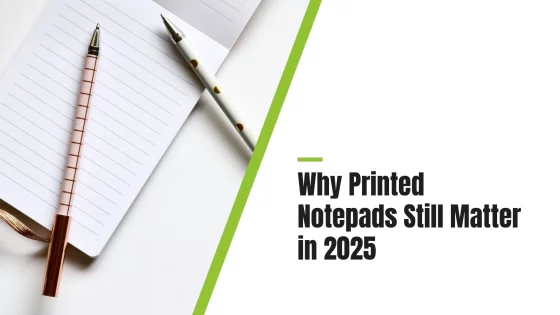How Are Printed Notepads Made and Why Are They Still Relevant in 2025?
Printed notepads are produced through a detailed process involving custom design, sustainable materials, and a variety of binding and sizing options tailored to branding and usability. Their ongoing appeal in 2025 stems from their practicality, marketing effectiveness, and the tactile experience they offer in an increasingly digital world.
In an age of digital dominance, branded notepads offer something unique. In 2025, these compact, customisable tools remain a practical staple in both professional and creative environments. This article explains how printed notepads are made—from paper choice to binding—and explores why they continue to add value for UK businesses and customers alike.
The Process of Making Printed Notepads
Printed notepads are crafted through a sequence of steps that allow full personalisation while maintaining production efficiency. The process starts with selecting the paper type and ends with cutting and binding the final product. For time-sensitive projects, many businesses choose express products to ensure faster turnaround.
- Design setup using brand logos, grid layouts, or messaging
- Glued notepads, wire-bound, or stapled bindings
- Size selection—common options include A4, A5, A6, and custom cuts
- Finishing options such as specific notepads tailored to niche sectors
Once printed, the sheets are assembled, bound, and trimmed. Many UK printers use recycled materials and sustainable inks to support eco-conscious practices.
Key Reasons Printed Notepads Remain Relevant
- Distraction-free productivity: Handwriting allows clearer thought without screen fatigue
- Accessibility: No batteries, apps, or updates required
- Memory reinforcement: Handwritten notes improve learning and recall
- Marketing impact: Branded notepads offer ongoing visibility
- Low cost, high return: Ideal for promotions, events, or welcome kits
Durable options like wirobound notepads are ideal for teams or client use where longevity matters.

What Goes Into the Design?
Designing a notepad involves more than adding a logo. The structure, layout, and usability all contribute to how well the notepad supports its intended use, whether it’s for internal tasks, external promotion, or industry events.
Design options typically include:
- Brand colours and fonts
- Contact information and taglines
- Grids, checkboxes, or blank layouts
- Cover design with optional protective layers
High-quality pads stay in use longer, keeping your brand in view. Unlike single-use marketing materials, printed notepads become part of someone’s daily routine.
Sustainable Materials and Eco Printing
Many UK businesses now request printed notepads made with ethical materials and processes. Printers are meeting this demand with greener solutions, without sacrificing quality or style.
Common sustainable choices include:
- FSC-certified or recycled paper
- Vegetable-based and soy inks
- Plastic-free and compostable bindings
- Carbon-neutral delivery options
Eco-focused businesses can align their branded materials with their values. For a detailed guide, see The Anatomy of a Perfect Notepad: Paper, Binding, Size & More.

Handwritten Notes vs Digital Devices
- Better retention: Handwriting encourages slower, more deliberate thinking
- Screen breaks: Physical writing helps reduce tech overload
- Durability: Notepads aren’t vulnerable to crashes or battery loss
- Hybrid use: Notes can be scanned or photographed for archiving
Who Uses Them and Why?
Notepads are used by professionals, educators, creatives, and administrators. They’re also ideal for events, conferences, and onboarding packs.
Common users include:
- Consultants: For strategy sessions and fieldwork
- Schools and training providers: For note-taking and course distribution
- Designers: For sketching, drafting, and visual exploration
- Retailers: For packing notes, vouchers, and thank-you messages
- SMEs: For low-cost branded visibility
Popular formats range from A3 custom notebooks for large-scale planning to DL custom notebooks for compact giveaways.
Choosing the Right Notepad for Your Business
Choosing the right notepad depends on your brand goals, audience, and intended use.
Consider the following:
- Size: A5 for daily use, A6 for giveaways, A4 for team note-taking
- Paper: Sustainable, white, cream, or custom stock
- Binding: Glued, wire-bound, or stitched
- Layout: Ruled, plain, gridded, or checklist formats
- Quantity: Larger volumes lower unit cost
Choosing a well-made notepad ensures better usability and longer exposure to your brand.
Conclusion: A Smart Tool That Still Works
Printed notepads are crafted with care and purpose, from eco-conscious materials to clever design layouts. In 2025, they remain a relevant, cost-effective, and reliable branding solution for businesses across the UK.
Considering printed notepads for your next campaign? Take the time to choose the right format, and let your brand be seen and used daily.
Frequently Asked Questions
Yes. We now offer FSC-certified paper, vegetable-based inks, and biodegradable glues as standard options for sustainable printing.
Glued and wire-bound methods are both widely used. The choice depends on how flat you want the notepad to lie when open.
Yes. Printed Notepads offers low minimum order quantities, especially for express products or events-based orders.
